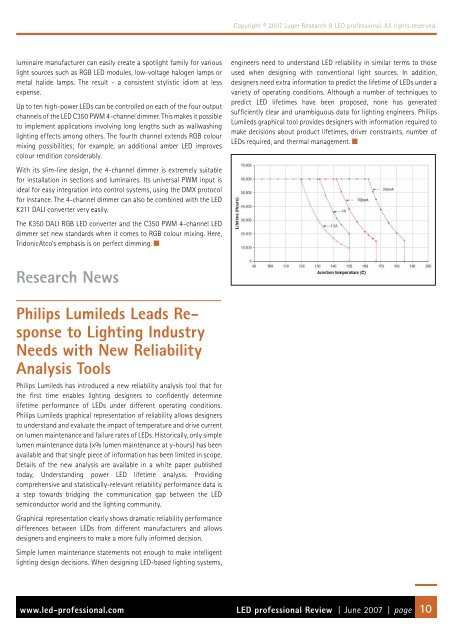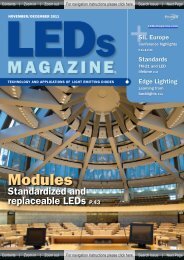LED drivers Phosphor technology - Beriled
LED drivers Phosphor technology - Beriled
LED drivers Phosphor technology - Beriled
You also want an ePaper? Increase the reach of your titles
YUMPU automatically turns print PDFs into web optimized ePapers that Google loves.
luminaire manufacturer can easily create a spotlight family for various<br />
light sources such as RGB <strong>LED</strong> modules, low-voltage halogen lamps or<br />
metal halide lamps. The result - a consistent stylistic idiom at less<br />
expense.<br />
Up to ten high-power <strong>LED</strong>s can be controlled on each of the four output<br />
channels of the <strong>LED</strong> C350 PWM 4-channel dimmer. This makes it possible<br />
to implement applications involving long lengths such as wallwashing<br />
lighting effects among others. The fourth channel extends RGB colour<br />
mixing possibilities; for example, an additional amber <strong>LED</strong> improves<br />
colour rendition considerably.<br />
With its slim-line design, the 4-channel dimmer is extremely suitable<br />
for installation in sections and luminaires. Its universal PWM input is<br />
ideal for easy integration into control systems, using the DMX protocol<br />
for instance. The 4-channel dimmer can also be combined with the <strong>LED</strong><br />
K211 DALI converter very easily.<br />
The K350 DALI RGB <strong>LED</strong> converter and the C350 PWM 4-channel <strong>LED</strong><br />
dimmer set new standards when it comes to RGB colour mixing. Here,<br />
TridonicAtco‘s emphasis is on perfect dimming.<br />
Research News<br />
Philips Lumileds Leads Response<br />
to Lighting Industry<br />
Needs with New Reliability<br />
Analysis Tools<br />
Philips Lumileds has introduced a new reliability analysis tool that for<br />
the first time enables lighting designers to confidently determine<br />
lifetime performance of <strong>LED</strong>s under different operating conditions.<br />
Philips Lumileds graphical representation of reliability allows designers<br />
to understand and evaluate the impact of temperature and drive current<br />
on lumen maintenance and failure rates of <strong>LED</strong>s. Historically, only simple<br />
lumen maintenance data (x% lumen maintenance at y-hours) has been<br />
available and that single piece of information has been limited in scope.<br />
Details of the new analysis are available in a white paper published<br />
today, Understanding power <strong>LED</strong> lifetime analysis. Providing<br />
comprehensive and statistically-relevant reliability performance data is<br />
a step towards bridging the communication gap between the <strong>LED</strong><br />
semiconductor world and the lighting community.<br />
Graphical representation clearly shows dramatic reliability performance<br />
differences between <strong>LED</strong>s from different manufacturers and allows<br />
designers and engineers to make a more fully informed decision.<br />
Simple lumen maintenance statements not enough to make intelligent<br />
lighting design decisions. When designing <strong>LED</strong>-based lighting systems,<br />
Copyright © 2007 Luger Research & <strong>LED</strong> professional. All rights reserved.<br />
engineers need to understand <strong>LED</strong> reliability in similar terms to those<br />
used when designing with conventional light sources. In addition,<br />
designers need extra information to predict the lifetime of <strong>LED</strong>s under a<br />
variety of operating conditions. Although a number of techniques to<br />
predict <strong>LED</strong> lifetimes have been proposed, none has generated<br />
sufficiently clear and unambiguous data for lighting engineers. Philips<br />
Lumileds graphical tool provides designers with information required to<br />
make decisions about product lifetimes, driver constraints, number of<br />
<strong>LED</strong>s required, and thermal management.<br />
www.led-professional.com <strong>LED</strong> professional Review | June 2007 | page 10

















